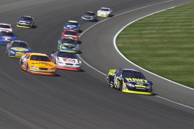Speed

You are probably familiar with the concept of speed. Speed is a type of rate. A rate tells you the amount of something that occurs during a given unit of time. If you know the distance an object travels in a certain amount of time, you know the speed of the object. For example, if a car travels 70 miles in one hour, the car is traveling at a speed of 70 miles/hour (miles per hour).
If the speed of an object does not change during its motion, the object is traveling at a constant speed. Most cars are equipped with cruise control. Cruise control allows a car to travel at a constant speed.

Most objects do not move at a constant speed very long. Most moving objects change speed many times while in motion. The marathon runners pictured here do not run at a constant speed during the entire race. At the starting line, there are many runners crowded together, so the runners are forced to move slowly. As the crowd thins out, a runner can increase his or her speed. The runner may slow down as he or she climbs a hill and increases speed going down the hill. When the race is over, a runner may calculate his or her average speed. The average speed of an object tells you the average rate at which it covers distance.


